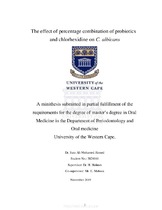| dc.description.abstract | Background:
Candida is a normal commensal of the oral cavity; these microorganisms can be isolated in 20% to 80% of healthy individuals. Oral candidiasis (OC) is the most common fungal infection related to the oral cavity caused by the most common opportunistic fungus (C. albicans). The management of oral candidiasis involves removal or reduction of predisposing factors together with the administration of an antimitotic agent either in topical or systemic form with or without chlorhexidine (CHX). The increasing number of people who are immunosuppressed and the development of antimicrobial resistance, has necessitated there is a need to explore others treatment to fight this infectious disease. This led to the exploration and use of beneficial microorganisms (probiotics) as an alternative prophylactic & therapeutic mode of treatment against Candida infections.
Aim:
To evaluate the effect of percentage combination of chlorhexidine (CHX) and probiotics on (PB) C. albicans growth.
Method:
The study was conducted in the Department of Oral Medicine and Periodontology and the Oral and Dental Research Laboratory (ODRL) at the Faculty of Dentistry, University of the Western Cape, Tygerberg campus. This in-vitro laboratory study was based on the established principle of spread plate technique followed by colony counting on selective media and non-selective media. Chlorhexidine (CHX) and probiotics (PB) were combined at different concentrations (XCHXyPB) (percentage combination), the added sum of which equals to 100 % (the percentage is achieved by multiplication of volumes (V*V)), to evaluate their effect on C. albicans. The treatments were incubated at 37°C for 30 minutes and 24 hours. Serial dilution was carried out on a micro-titer plate based on McFarland standards. A fixed volume (100 μL)
of the solution was transferred into plates (selective and non-selective media). Deionized water served as a control (negative).
Results:
100 μL CHX with 0 μL PB (100 CHX 0 PB) had a mean value of (0) at both 30 minutes and 24 hours. While 25 μL CHX with 75 μL PB (25 CHX 75 PB) the mean value (9.4) at 30 minutes and (9.5) at 24 hours. 0 μL CHX with 100 μL PB (0 CHX 100 PB) the mean value was (9.6) at 30 minutes while at 24 hours the mean value was (9.9). The control (0 CHX 0 PB) showed at 30 minutes and at 24 hours slightly similar reading (mean) as for the 0 μL CHX with 100 μL PB (0 CHX 100 PB). The largest difference was between the control (0 μL CHX with 0 μL PB) (0 CHX 0 PB) versus 100 μL of CHX with 0 μL PB (100 CHX 0 PB) (9.692), p <0.001. The smallest difference was between control (0 μL CHX with 0 μL PB) (0 CHX 0 PB) versus 0 μL CHX with 100 μL PB (0 CHX 100 PB).
Conclusion:
Chlorhexidine (CHX) and probiotics (PB) could be used at different combination concentration, provided that the CHX ratio is lower than the PB. Depending on the combination used, the number of colonies were slightly different. CHX (100 CHX) showed the lowest number of colonies (zero), while probiotics (0 CHX 100 PB) showed the highest number of colonies. Combination 25 CHX 75 PB showed reduction in CFU/mL. This means that CHX destroyed the organism which have already been established in literature, in comparison to probiotics which reduces the number of organisms (strain specific effect). These two effects are required when treating Candida infection, the treatment goal when treating Candida infection is to eradicate the organism but not completely, because if we completely eradicate the organism it will cause an unbalance in the normal flora of the oral cavity. Therefore, it is recommended that probiotics be administered to patients after being treated with CHX to avoid an imbalance in the normal flora. . Should these combinations be used simultaneously or subsequently is a question that requires further elucidation by research. | en_US |

